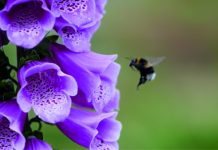We’re back! The garden centre is re-opening on 1st September and we’re ready and raring to go! We’ve been lucky enough to have a whole month in the Tarifa area, Atlantic coastline of Cádiz province where the weather is always a little cooler and a little – or a lot – breezier. Sometimes it’s enough to sandblast you but, with temperatures around 30C, cooler mornings and evenings, it was a welcome relief.
Our 10 minute walk to the beach was lined for a lot of the way with lantana camara, commonly just known as lantana. They were growing in pure sand, often with burning winds and, of course, no water throughout the summer at least. They marched beside us all the way to the tops of the dunes. We know and recognise them as a tough plant but I don´t think any of us think to grow them that tough! Yet they were fine big bushes and absolutely smothered with flowers.
Originally from Central and South America, lantana is a tropical and semi-tropical plant belonging to the verbanaceae family – you can see that immediately in the leaves and flowers. In warm conditions they are evergreen though, around Cómpeta, they will almost always lose their leaves in wintertime. They’re a wonderfully useful garden shrub, a real performer flowering from spring through to cold conditions. They have naturalised in parts of the Australian/Pacific region, parts of India, areas like California and Florida in U.S. and, of course, in Iberia. In some of those areas, their rampant nature has led them to be classified as noxious weeds. In Fiji, for instance, its bullying habits have taken over 50% of grazing ground, rendering it useless. And infestations are reported in parts of Africa, Asia, Australia, North and South America and many of the Caribbean and South Pacific Islands. It can spread to form very dense and impenetrable thickets, as we noted on our walks, but the bushes were full of birds and, in one area, there were obviously blackbirds nesting as they kicked up a raucous din every time we walked past them – even if we tiptoed! There’s a restaurant in the area named after the blackbirds so they’ve obviously been nesting there for a long time. I didn´t know, so had to check, blackbirds commonly produce three broods a year of three to five chicks but rarely use the same nest. I’d guess the lantana thicket is full of discarded
homes.
Lantana certainly grow best when treated hard. Overwatering, too much shade and poor airflow can cause sulking and fungal infectons such as mildew. With a height varying between 1m and 2m and 1m spread, they make good windbreak material and, once established, stand up to wind well. Livestock will usually keep well away from them as they are toxic to cattle, sheep, horses, goats, deer, rabbits, guinea pigs and rats – though male rats, horses and goats show less sensitivity. The rough-wrinkled leaves, that feel like cats’ tongues, can cause contact dermatitis in humans and the green berries are toxic if eaten, less so as they ripen, and, dangerously, looking remarkably like verge-grown blackberries. The entire plant has allelopathic tendencies, meaning it makes its own space by emitting a chemical that other plants dislike. The leaves are aromatic if bruised, though many gardeners find the pungent sage-like smell rather unpleasant.
The 5-lobed flowers form in dense clusters often in fluorescent shades of yellow, orange, red, pink, cherry, coral, peach, magenta, cream and white. They typically change colour as they mature, resulting in flower heads of two or three colours. The red-yellow combination is known as the Spanish flag. They are useful flowers for pollinators, swallowtail butterflies particularly like them. Then if you want to contain their spread, trim the green berries off as they form. In a garden situation, a yearly hard pruning in very early springtime keeps the bushes more compact and dense. But wear gloves and protective clothing.
There are over 150 recognised species of lantana but lantana camara and lantana montevidensis (syn. sellowiana) are the most popular and planted. This latter one is a ground-coverer and comes in lilac, yellow or white, but solid colours not mixed like l. camara. All are great splashes of much-needed colour in drought-hit summer gardens and they might bring the blackbirds with them!
Viveros Florena re-opens on 1st September after our summer break.
Hours: 9 until 2 during September, changing to winter hours, 10 until 4, in October.
Always closed on Sundays and Mondays.






















